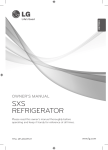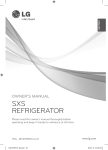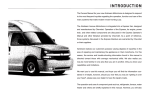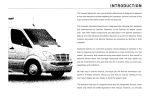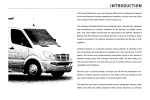Download 2012 Compiled Operating Notes
Transcript
2012 Compiled Operating Notes Trim Usage – Experience is teaching some good techniques… - In smooth water the most efficient trim setting is to go full bow DOWN. With a little chop you may find that backing off full down a couple of LED light positions will provide a more comfortable ride without sacrificing much speed. In small rolling waves, or crossing a larger boat’s wake, you will find that preemptively moving to the ½ tab position will produce the smoothest crossing. In heavy chop, larger waves, or very large wakes, it is best to remove all the trim in order to keep the bow as high as possible to prevent waves from slapping the bottom of the boat, and to keep water from coming over the bow. This will decrease the boat’s efficiency and cause for higher fuel burn. Keep large waves at 45 degrees to the bow if possible. Fuel Balance – Remember to keep your fuel balanced by using the electric switch on the port side of the instrument panel. A good technique is to burn ¼ tank from the Aux, then switch to the Main and burn ½ tank from there, thus always keeping them within ¼ tank of one another. Diesel fuel weighs about 6.7 pounds per gallon – 80 gallons equals about 536 pounds! (Also shoot to keep water in balance as well… water weighs even more, about 8 pounds a gallon – start adding grey water which is in the port hull and you can actually get the boat leaning to port). Grill & Stove Use – Please notify us if you use the grill or stove, this will give us the chance to clean those items as we may not check them otherwise. A good technique is to place notes on the yellow pad in the glove box – let us know what needs attention and if the boat is running out of anything that may need replacement. You can also write down maintenance items there or in the green log book, but please make sure you bring maintenance items to our attention, thank you. Day Trip Return Notification – Prior to departure please give us your best guess at a return time, but don’t feel obligated to meet that time unless we have to turn the boat for a next day trip. Simply have fun and enjoy yourself without worry, but we would simply ask that you notify us if you’re going to be more than ½ hour early/late so that we can also not worry and can take care of the boat after you’ve arrived. Bilge Pumps – There are seven bilge pumps on the boat, all have float switches to make them automatic. The lights next to the switch will turn green if these pumps are running – the light is very difficult to see in daylight but will stand out in low light. These float switches can fail, so if you hear something running, look for the light and report it to us. Kicker Stowage – Remember to close the vent on the fuel cap and to also turn off the fuel switch before stowing (make sure to turn them on before start, or your arm will be sore like mine, LOL). The Zodiac is great for exploring, just let me know if you would like it on the boat. Kayaks are coming soon. Also be sure to always set the kicker motor HANDLE DOWN. If you set it down with the handle up, then engine oil will flood the cylinder, it will spill oil, and will fail to start. Anchor use – Please be careful as you reel in the anchor… as the rope ends and the chain is about to come aboard, slow the windlass and make sure it is taking the chain properly. Again slow the windlass just prior to the anchor arriving so that it doesn’t bounce and strike the boat. If you get a stuck anchor, try pulling from a different position, but do not cinch down on the windlass clutch as this could damage the boat. If the anchor is stuck, it is far preferable to buy a new anchor than to experience damage. A spare anchor will be on the boat for trips north, but not for operations within the local islands. Remember, while in the marina idle is your friend! Sea Water Impellor – Gateway I’s cooling system draws in salt water from inside the starboard hull just below the water line. An engine driven sea water impellor is what draws this water in. The water is then moved through an aluminum heat exchanger where it is used to cool the engine coolant. The engine coolant also has its own pump, Gateway Yachts – Adventure Yachting Excellence… but that impellor is much more reliable than the sea water impellor as it is not exposed to the possibility of running without water flow. While running the boat I immediately noticed that the temperature rose above 180 degrees. First 185, then with higher power settings the temperature rose up to 190+. When I returned to the marina it rose back to 190+ at idle – definitely not normal. The good news is that Aspen designed the boat to have some water flow just from the pressure created on the inlet while the boat is in motion. I called out our mechanic and sure enough the impellor blades were almost totally gone! What could cause the sea water impellor to run without water? Several things – remember that it is drawing in water pretty strongly, so things floating on or just under the surface can be drawn into the screen that covers its entrance. Things like plastic garbage bags can be picked up quite easily and it only takes a few moments of running dry before damage to the rubber-like blades begins to occur. Seaweed can also block the entrance, but that’s not likely while the boat is in motion. A sure way to run the pump without water is to have the sea water intake handle closed (horizontal), which in this case it was in the proper (vertical) position. The lesson here is to pay attention to the temperature… any temp above 180 degrees is not normal and should prompt an immediate investigation of the sea strainer, water intake handle, and it should generate a call to Gateway for help. Also, if you are passing over debris in the water, try not to pass over it with the starboard hull if you have the choice. A spare sea water impellor now resides inside of the starboard oil/spare compartment. Cutting Board – We are trying to keep one side of the stove’s wooden cutting boat in show condition. I have now marked that side, “no cut this side.” So if on an extended trip, please flip it over and remember that there are three plastic cutting boards under the sink, right side. Boat mats – Please make sure to bring the Gateway Yacht blue mats inside the boat at night or if you’re leaving it unattended, that will help keep them nice, thank you. Catering – we have been using Gere-a-Deli for catering, this is pretty easy, cost effective, and delicious! You can examine their catering menu at their site and simply let us know what you would like and it will be waiting for you on the boat. DIESEL Fuel – On a recent trip to Alderbrook Resort on Hood Canal, Connie and I stopped at a little marina called “Hood Canal Marina” just north of Alderbrook for some fuel. Generally I avoid little, seldom used, marinas as you never know how old or what condition the fuel is in, but we wanted to make sure we had plenty for the return. The attendant came out, turned on the pump and handed me a green hose without saying a word. I noticed the pump handle was black and so I asked, “Diesel fuel, right?” “Ahh, no, that is unleaded… that boat take diesel?” “Hmmm,” I replied. “Aren’t diesel fuel hoses supposed to be green and unleaded black?” Nothing but a blank stare in return… Good thing I noticed and asked. A good attendant will ask every time, especially if they are unfamiliar with the boat as this gentleman obviously was. Be careful out there! Hard Schedule Bid is finished and went very well thanks to our wonderfully cooperative owners! Thank you all, it is a pleasure working with such a high level group! Coast Guard Boarding – Last month one of our owners was stopped by the Coast Guard for a vessel safety and environmental inspection. This is another good reason to review where the safety items are located and also where all the placards are located. o Fire Extinguishers – one up front just left of the Captain, another on the aft wall of the quarter berth. o Life vests – one for each person on board, maximum of 8 people on board a C90. Generally we keep three in the quarter berth, 4 under the bed, and two automatic PFD’s under the Captain’s seat. o Flares and first aid kit are also located under the Captain’s seat. o Placards – most placards are under the wooden quarter berth tip-up/counter top. Two new placards are now required… one is a Waste Managemetn plan placard that is affixed to the wall in the cabinet Gateway Yachts - Making Waves… under the sink, and an environmental placard is affixed to the starboard wall inside the engine compartment. There are also placards inside the oven door, and one on the LPG tank lid. Y-Valve – This is an environmental issue regarding the discharge of black water from the holding tank. It is something the Coast Guard looks for and they may not understand the design of the Aspen because it does not have a Y-valve like most boats… In boats that have a Y, there is one exit from the holding tank and the Y-valve directs the flow of waste either to the pump out location or through a macerator pump to overboard. In the Aspen, Larry Graf went to the trouble to install two separate exits from the holding tank – one solely for pump out, the other solely for exit overboard via the macerator pump. The key terminology is that the waste must be “secure.” It is secure in the Aspen, as it cannot exit the boat without direct human input via either pumping it out (preferred) or by holding the spring loaded macerator switch. Junior Coast Guard personnel may not understand that there doesn’t have to be a Y-valve… there isn’t one when the system has two separate exits from the tank, this negates the Y-valve altogether. Towels – Left on the rack, they are assumed to be clean. Windows, Hatches, & Portholes – Prior to moving the boat, the Captain should take inventory of what’s open and what’s not. Portals are easy to leave open, especially when spending the night onboard. Please make sure they are closed prior to leaving the boat, so that when it rains, or if we go to clean the boat with a hose, moisture won’t find its way inside. Captain’s Window Screen – It seems like this gets displaced from its frame every other trip! What’s happening is that when the Captain’s chair is folded forward its port-side armrest strikes the screen if it is left in the up position (stowed). The solution? Please keep the left armrest down when moving the chair up. Water Taste bad? If the tanks are filled with the garden hose, it definitely will taste bad. Please use the white potable drinking water hose to fill the tanks. While it’s only 25’ long, you can move the boat or combine it with a borrowed hose if necessary. The garden hose is 50’ long and is stowed in the port lazarette during extended trips. Its purpose is to rinse salt/dirt from the boat. You’ll find that rinsing the boat upon arrival at a dock with fresh water will make your stay much more comfortable, is good for the boats’ brightwork, and will keep the gelcoat from becoming dull. Spray all surfaces of the boat and spray the [closed] windows directly, it will make looking at the beautiful scenery much more pleasant! Zodiac Oarlocks – These are made of plastic and cannot handle large rowing loads. Please be gentle when rowing or use the kicker motor, thank you. Fender Height – Fenders should be adjusted so that the bottom remains out of the water. Mooring Rope – There is a new 40’ long black and gold mooring rope that is the right rope for tying up to a buoy. It will be stowed in the aft port transom stowage next to the LPG tank. Spare Anchor – There is now a spare anchor available. Like the primary, it is also an all aluminum Fortress anchor, but is one size smaller (it is actually the right size for the boat, the primary is oversized). The spare anchor rode has an anchor swivel, 20’ of chain, and 300’ of rope (versus the primary 40’ of chain and 400’ of rope). The spare will be placed on the boat for trips north or if desired for local outings. Times when it might be of use is to secure the boat in a limited space, to secure the boat against high winds, or should you snag the primary anchor and be unable to retrieve it. If that happens, try pulling the anchor from different directions, but do not apply too much force as you can damage the boat – a new anchor will cost you less than repairing the boat, so please be careful and if you are able to seek assistance with a stuck anchor, please do. New Ropes – In addition to the new 40’ mooring rope, we have added 200’ of floating triple-strand nylon rope that can act as a stern line for the boat (while at anchor), and can also work to secure the dinghy. There are two 100’ ropes, if you need the full 200’ length you’ll need to tie them together. Gateway Yachts – Adventure Yachting Excellence… New Chart Plotter “Vision” Charts - This extends the map coverage from the south end of Puget Sound up to the northern tip of Vancouver Island. It also provides satellite imagery, photos of marinas, as well as many other functions that the data base did not previously have. On your next outing be sure to have us go over the changes with you, it’s quite an improvement! Excessive Use of Force! On a recent charter with teenagers aboard, several items were broken or marred from excessive use of force. Using too much force that leads to breakage/damage is usually the result of impatience. As owners, and as the Captain of your vessel, each of us is responsible to prevent damage. One way to do this is to include it in your briefing to younger people – “If something doesn’t give the desired result easily, investigate why – do not force it!” Sure stuff happens, it’s a boat after all! And not everything on a boat is made of solid steel (heavy) – we try to purchase the best products available, but sometimes they break – if they are made of plastic, then care must be taken. On a charter, all items broken or damaged are replaced using funds from the charterer’s damage deposit, while owners on board while damage occurs are simply invoiced. Most pure charter companies are hesitant to use deposit money as they want their charter customers to return, so they often pass on these costs as maintenance costs to the boat owners – or they don’t get fixed at all. Rest assured that our desired culture and reputation is to provide boats that are new or like new and any damage will get repaired at the expense of those who are using it at the time. A quality reputation is superior to repeat business, especially if the repeat business is abusive to the boat. Time! It takes a tremendous amount of work to clean and maintain the boat – there is at least 4 to 6 hours of work that follows every use. If two people work it, then we can cut the time almost in half, and that’s what we do if the turn to the next day is tight. If the boat does turn the next day to another customer, then you can see how important it is to get the boat back with enough daylight left for us to get that work accomplished – and it is now getting dark earlier as we get closer to fall. On charters we have set 1:00 PM as the time that charter customers must return the boat to the slip. For owners, that time is going to be 2:00 PM for return on your last day of use unless coordinated otherwise. Obviously that will depend on the schedule, and it is highly likely that keeping it out later will be okay. If you are using Open Time, then it may be possible to keep it out late, but I would like for the standard to be that our owners ask about it and that we set a time that works for everyone. We have a great group of owners, for that we are all thankful! But once a time is set, then it is important that time be honored as we hire employees and it is costly to have them just standing around. Boating is funny, time wise, in that getting ready or getting back always seems to take longer than we think. And to us, “getting back” means that we can get on the boat and help you on your way, then take care of the boat. But if you have to clear customs, or run over and put fuel in the boat, pump out the holding tank, or whatever (stuff we’d gladly do ourselves and actually are faster at it), then it eats into the time we have to get the boat ready, so please account for these things when timing your return. We know that everyone does their best. All we ask is that we coordinate a time, and then stick to it or notify us with enough time to adjust. We don’t want a program where the owners do the cleaning (like everywhere else), and we don’t want to have to start charging for standby time, that’s not our goal, obviously. Thanks for your understanding. Light Bulbs. On Gateway I there are two types of lights – Incandescent, and LED. The swivel lights above the dinette, the ceiling light in the restroom, the light just to the right of the Television, the reading lights near the pillows, and the hand-hold-like swivel lights are all LEDs, the rest are incandescent. The LEDs use far less energy, put out far less heat, and last far longer. If possible, please use the LED lights as much as possible. The incandescent red/white bulbs are very short lived, I just changed four of them on the boat’s last turn. To make them last longer, favor the LEDs, turn the “Lights” Gateway Yachts - Making Waves… circuit breaker off on the DC panel if not needed, and please make sure to turn the engine compartment light off. There are freshly stocked spares located in the small items kit in the spare/oils compartment, or preferably, just notify us of burned out bulbs and we’ll replace them. Customs Worksheet. Attached is a Customs Worksheet, they are stocked in a plastic sleeve near the end of the Gateway Manual (located in the glove box). This form will help you organize all the information required before going through customs both ways. Lost in the Fog? As I type and glance out the window, it is what we call in the flying world, “Zero, Zero,” meaning no visibility either horizontally or vertically. Fall is definitely fog season, although it can occur any time of year over the water, even in the middle of summer like today. This is exactly why the boat has GPS and Radar installed on it, it behooves us all to know how to use it, and how to interpret what it’s telling us. If you’re interested in learning a little more about it, let me know and we can arrange a session to go into it as deeply as you like. It’s best to be on the boat, of course, so perhaps we can arrange a day when the boat’s not scheduled, or combine it with the beginning of your next trip. Refrigerator Reminder – Please make sure to leave on both DC Sub Panel Switches along with the refrigerator switch. Really the only time to leave these off is for power conservation, but be aware that the freezer will then defrost sending water into the bottom of the fridge and eventually out onto the wood floor. DVD Won’t Come Out – Took me at least 30 minutes to figure this out the first time! Now it’s happened to several others… you go to eject your disc and it simply won’t, and there’s no eject button on the TV itself. Here’s what’s happening – the TV has gone to some other source than DVD, and thus the eject button becomes disabled (engineer was “design challenged”). The fix is to select “SOURCE” on the remote, then “DVD,” and then hit the little red eject arrow, and it will then eject. Oars Done Right – The Zodiac oars can fall out of the oar lock while the boat is tipped up on its davit if they are not installed properly for transport. Haven’t lost one yet, but would like to keep that record going! Since a picture is worth a thousand words, here’s what it looks like done the incorrect way, aluminum oar sections in black rubber holder, oars extended well beyond the end of the dinghy: As the black rubber ages it becomes looser. It is designed to fit around the black plastic portion of the oar which is thicker. In the correct position the oars hang only slightly beyond the length of the dinghy, thus lowering the risk of having it catch water while the boat’s in motion. Here’s what it looks like installed properly: Winterizing the Boat – As freezing temperatures near, Gateway will place the boat in a “semi-winterized” state. It will still be quite useable and capable of cold weather travel, but it will have the water system secured and treated with RV antifreeze to protect the water lines and Gateway Yachts – Adventure Yachting Excellence… equipment. We also place a space heater and dehumidifier on the boat to keep it warm and free of moisture. If a severe cold spell comes then we even drain the toilet valves and take other precautions as well. Operating the boat in the winter months is fun and the heater ensures you will stay toasty warm. Obviously you’ll have to pay closer attention to the weather and we’ll help with that so that your boating experiences are only good ones. Next time you take the boat out, ask me to review the heater controls as well as to get some radar operating tips! Over the Rail! Speaking of rails, I have twice now witnessed passengers during docking climb over the bow rail with dock lines. They think they are being helpful, but in fact are risking their own safety as well as possible damage to the boat – thank goodness for sturdy 1 ¼” rails installed correctly by Aspen! But the risk is that a person slips and gets in between the boat and the dock as it is docking. Captains, please don’t let this happen, there is no reason with bow and stern thrusters to have passengers on the bow while docking – make sure they are briefed. Instead position them aft, ready to get on the dock and attach the bow line from the dock. Autopilot/chart plotter settings – Everyone likes things set up a certain way, that’s understandable. However, a changed setting can actually be a safety item, like what happened to me recently… I turned on the autopilot and began adjusting headings, but the cursor and boat did not respond as expected. I was forced to go heads down to investigate, thus doing the opposite of the reason I turned it on to begin with. Having the autopilot on can create awareness by relieving the mundane tasks so that attention can be focused on higher level things like looking out for rocks and logs! Instead, I had to find “Setup” and then search for the heading bug mode which had been changed to a different setting. So, changing settings is fine, but if you do, please put the settings back to where they were so that the boat is in a consistent state every time (or at least most of the time). Thank you. Baked & Caked Grill – The Magma grill is nice to have and use, and we do want Gateway to clean it to save wear on the inside of the boat. Again, please let us know if it’s been used. However, a couple of times now it has come back caked with sticky sauce that has literally taken more than an hour, two scotch pads, and even steel wool to get clean! Since it’s a boat, grilling food that doesn’t make a big mess in the first place is probably best, but if you do then perhaps taking some pre-emptive steps can save some of the work. o Use foil over the grill if possible, even pre-line the grill bottom with foil. o Use the spray olive oil that’s provided in the boat to make a non-stick surface. o If it is an extraordinary mess, then perhaps taking it onto shore and cleaning it is best, thank you. Fridged – The NovaKool refrigerator in the boat is a good one that consumes very little energy. However, it is obviously not frost free. If the fridge is without power, the frost on the freezer melts, falls to the bottom of the fridge, and then runs out the door soaking the carpets. It’s hard to tell the carpets are wet unless you pick them up – on two recent cleanings they were soaked and beginning to smell a little funky, yep, the power switches were off. To make sure the refrigerator remains powered, leave the Refrigerator switch on the upper switch panel on. Also make sure to leave both the DC bus “Sub Panel” circuit breakers on (turn the rest of the DC switches off unless needed). The only time I would turn the fridge off is to defrost it, or if you were trying to maximize the conservation of battery power. But for most situations, even overnight with only the battery, leaving the fridge on is fine and will not draw down power. Heater– Gateway I has a Wallas forced air diesel heater. Works good! Come use the boat on a cool day this time of year, it’s beautiful boating! The heater is simple, quiet, uses almost no electricity and so little fuel you’ll not even notice. It simply drips drops of diesel into a pan and uses an electronic igniter to light a small fire. Old Gateway Yachts - Making Waves… versions of this heater had manual controls while Gateway I has a new electronic version. It was common on the older versions that people would try to get the furnace to light and would make so many attempts that the igniter would get too hot and literally melt the plug and surrounding metal! Gateway I’s electronic controller is more like a modern home furnace in that it will only allow 3 start attempts before locking you out. There are two primary reasons the furnace may not light: 1. The heater is not primed with fuel – if it sits too long (like several months) without being used then it could lose its prime and would thus possibly require a couple start attempts. On Gateway boats this should not be a problem as our boats get used and thus the heater is used on a regular basis. 2. The start cycle is interrupted. Starting the furnace takes a couple minutes… anything done to manipulate the controls while it’s going through a start cycle will interrupt the start attempt and likely result in a failed start – interrupt it 3 times and it will lock you out. It’s a good idea to be in the habit of allowing a cooling period if you get a no light. If you get locked out, please allow it a cooling period of at least 10 minutes, then you can attempt to reset the computer. To do that, locate the “heater” fuse in the panel behind the dash, above the bed. Pull the fuse then reinsert, that will reset the computer and allow more attempts. It’s also a good idea, however, to know what the source of the failure is before just trying and trying, so if in doubt you can always call Gateway to help troubleshoot. Anchor Pulpit – Just a reminder that it’s possible to bend the pulpit! It can be bent if the anchor windlass is run full speed to the up position, and also if the windlass is set with too much torque. My technique to prevent damage, to both the bow of the boat and the pulpit, is to operate the winch with the foot switches up on the bow. As the anchor comes out of the water (use the boat hook to push the mud off), stop the anchor and slowly bring it up into position through the pulpit gate. I carefully guide it so that the anchor tines don’t hit the gelcoat and so that it doesn’t slam into position. Once the anchor is in place you should see the windlass begin to readily slip – if it doesn’t then it’s adjusted with too much torque. If you see this, please let us know and we’ll adjust it properly. Don’t forget to lower the little red tab that allows the windlass to catch, that way the anchor and rode won’t accidently feed out and it will also keep tension off the windlass motor. Practice with the radar – “Think like a radar beam!” If you imagine energy leaving the radar antennae, picture in your mind how most of the energy will skip off the water and never return. Energy that strikes something substantial will reflect that energy back to the antennae and be shown on the screen as a return. It will dramatically improve your use of the radar if you practice with it on during good weather, that way you correlate real world objects with what the radar displays to you. Practice makes perfect! Lessons come to a “Head!” Of course the boat head is not like the toilet in your house – the typical house drainpipe is three to four times the diameter of the boat’s. The boat’s head uses an electric macerator to grind any solid matter as it exits the toilet, then it is fed all the way back to the holding tank. If too much solid waste is put into the small drainpipe at one time, with too little water to carry it, then the line will plug. This is an expensive and messy fix as the toilet has to be completely removed. Gateway’s mechanic, Carl, offers some advice to prevent clogging: Use a lot more water than you think during a flush – hold the button down for 10 full seconds anytime solid matter goes down the bowl, one-thousand one, one-thousand two, etc. This will ensure that the solids make it all Gateway Yachts – Adventure Yachting Excellence… the way to the tank and won’t compile one flush on top of the other. Oh, and break up heavy ‘loads’ into multiple flushes. Cabin Door – if open during cruise, salt spray will build up on the inside of the glass and the interior of the boat making cleaning difficult. Sometimes that may be necessary for ventilation, but if possible it will keep the boat nicer if the door is closed while underway, especially at higher speeds. Maintenance Expenses – Over the course of the past 9 months we have spent $4,677 just on Gateway I maintenance, and we still have annual haul-out and bottom paint to go this year. Gateway’s been very liberal in covering expenses, and worked hard to keep additional expenses off our owners. Now that we’ve all been in the program awhile and have gained experience with the boat we need to tighten up a little in charging owners for maintenance that’s required as a direct result of their use or misuse. . Be sure to check the weather and tides before departure! Gateway Yachts » Fishing and Weather Reports Gateway Yachts - Making Waves…









